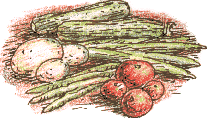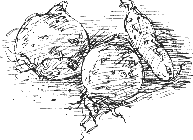
|
Touch the EarthThursday, 10th July 2003, West Yorkshire |
![]()
![]()
![]()
![]() Rocks | History |
Workshop |
Links | Home
Page
Rocks | History |
Workshop |
Links | Home
Page
![]()
 This
summer I feel the need to touch the earth, so much so that, when I've
got an hour free, I'm more likely to go down the garden and start digging
than sit at the computer and catch up with this diary.
This
summer I feel the need to touch the earth, so much so that, when I've
got an hour free, I'm more likely to go down the garden and start digging
than sit at the computer and catch up with this diary.
Henry Williamson (1895-1977), author of Tarka the Otter (1927) once said that he'd got to the stage where (I'm quoting from memory here, this was a television documentary of c.1970):
'I could describe a field of wheat “billowing golden in the breeze”, but could I grow a field of wheat?'
He turned to farming, taking a farm in Norfolk.
It might not be on that scale but at least I've found it satisfying this year having that extra bit of time to grow vegetables.
Earthscape
 I'm
continuing digging over my meadow area which is roughly twelve feet square.
As this piece of the garden has been neglected and used as a dumping ground
- for piles of twggy debris, old wood chip from the paths and bulbs dug
out from elsewhere in the garden - the soil is more varied than it is
in the regularly cultivated parts of the garden. There's a secret earthscape
beneath our feet of saffron-stained dock tap roots and wriggling nettle
rhizomes, a spreading network of mycelium and huddles of dormant bulbs
- like Russian dolls, the whole plant, flower-and-all packed inside -
waiting for the spring.
I'm
continuing digging over my meadow area which is roughly twelve feet square.
As this piece of the garden has been neglected and used as a dumping ground
- for piles of twggy debris, old wood chip from the paths and bulbs dug
out from elsewhere in the garden - the soil is more varied than it is
in the regularly cultivated parts of the garden. There's a secret earthscape
beneath our feet of saffron-stained dock tap roots and wriggling nettle
rhizomes, a spreading network of mycelium and huddles of dormant bulbs
- like Russian dolls, the whole plant, flower-and-all packed inside -
waiting for the spring.
 For
instance, when I dig into the old wood chip there's a smell of mushrooms.
Many of the chippings are laced with filaments of white mycelium - the
vegetative growth of the fungus.
For
instance, when I dig into the old wood chip there's a smell of mushrooms.
Many of the chippings are laced with filaments of white mycelium - the
vegetative growth of the fungus.

 I've
learnt to distinguish the two types of bulbs that thrive here: snowdrops
(left) are like small, purplish-brown-skinned onions, the size
of a finger nail (one of my fingernails) while bluebells
(right) look more like small white new potatoes when you come
across them in the dark earth. They're about the size of lychees and don't
seem to have any 'onion skin' covering. As I've said before, I think these
are the garden variety, originating in Spain.
I've
learnt to distinguish the two types of bulbs that thrive here: snowdrops
(left) are like small, purplish-brown-skinned onions, the size
of a finger nail (one of my fingernails) while bluebells
(right) look more like small white new potatoes when you come
across them in the dark earth. They're about the size of lychees and don't
seem to have any 'onion skin' covering. As I've said before, I think these
are the garden variety, originating in Spain.
 It
seems to be the season when earthworms tie themselves
in convoluted Celtic knots.
It
seems to be the season when earthworms tie themselves
in convoluted Celtic knots.
 When
I walk away, a young robin, brown and speckled all over,
comes and investigates the bed that I've been digging. When I return he
hops into the hedge.
When
I walk away, a young robin, brown and speckled all over,
comes and investigates the bed that I've been digging. When I return he
hops into the hedge.
![]()
![]() Next page | Previous page |
This day in
2000 | This month |
Nature Diary |
Home
Page
Next page | Previous page |
This day in
2000 | This month |
Nature Diary |
Home
Page
![]()